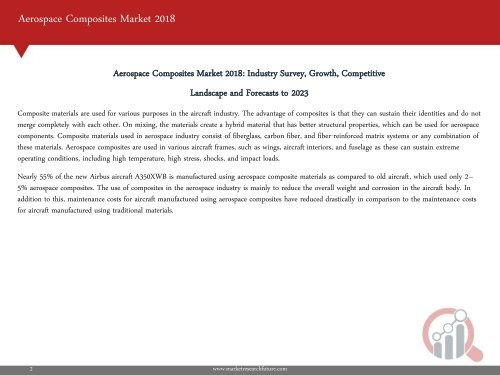Aerospace Composites Market
You also want an ePaper? Increase the reach of your titles
YUMPU automatically turns print PDFs into web optimized ePapers that Google loves.
<strong>Aerospace</strong> <strong>Composites</strong> <strong>Market</strong> 2018<br />
<strong>Aerospace</strong> <strong>Composites</strong> <strong>Market</strong> 2018: Industry Survey, Growth, Competitive<br />
Landscape and Forecasts to 2023<br />
Composite materials are used for various purposes in the aircraft industry. The advantage of composites is that they can sustain their identities and do not<br />
merge completely with each other. On mixing, the materials create a hybrid material that has better structural properties, which can be used for aerospace<br />
components. Composite materials used in aerospace industry consist of fiberglass, carbon fiber, and fiber-reinforced matrix systems or any combination of<br />
these materials. <strong>Aerospace</strong> composites are used in various aircraft frames, such as wings, aircraft interiors, and fuselage as these can sustain extreme<br />
operating conditions, including high temperature, high stress, shocks, and impact loads.<br />
Nearly 55% of the new Airbus aircraft A350XWB is manufactured using aerospace composite materials as compared to old aircraft, which used only 2–<br />
5% aerospace composites. The use of composites in the aerospace industry is mainly to reduce the overall weight and corrosion in the aircraft body. In<br />
addition to this, maintenance costs for aircraft manufactured using aerospace composites have reduced drastically in comparison to the maintenance costs<br />
for aircraft manufactured using traditional materials.<br />
2<br />
www.marketresearchfuture.com


















